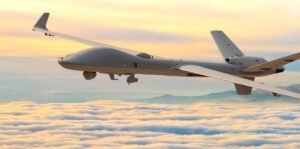
"Nagastra-3: India’s Devastating AI-Powered Loitering Drone"
In an era where unmanned systems are reshaping modern warfare, India has taken a giant leap forward with the development of Nagastra-3—a next-generation, AI-powered loitering munition designed to deliver precision strikes with lethal autonomy. As a key player in the global defense landscape, India’s indigenous drone technology is not just catching up but setting new benchmarks in swarm warfare, artificial intelligence (AI)-driven targeting, and battlefield dominance.
- What makes Nagastra-3 a game-changer in modern combat?
- How does its AI and loitering capability outmatch rivals?
- Why is it a strategic nightmare for adversaries?
- The future of Indian drone warfare and its global implications.
1. What is Nagastra-3? India’s AI-Enabled ‘Suicide Drone’

Definition & Role in Warfare
Nagastra-3 is an indigenously developed loitering munition (also called a “suicide drone”) by Economic Explosives Limited (EEL), a subsidiary of Solar Group, in collaboration with India’s Defense Research and Development Organization (DRDO).
Unlike traditional drones that return after a mission, a loitering munition is designed to hover over a target area, identify threats, and then crash into the enemy with an onboard explosive—essentially acting as a smart missile with a reusable brain.
Key Features
AI-Powered Target Recognition – Uses machine learning algorithms to distinguish between friend and foe, reducing collateral damage.
Long Loitering Time – Can patrol for hours before striking, waiting for the perfect moment.
Swarm Capability – Multiple drones can communicate and attack in coordinated waves, overwhelming enemy defenses.
GPS-Denied Navigation – Operates even when enemy jamming disrupts satellite signals, using inertial navigation and visual tracking.
Kamikaze Strike Mode – Detonates on impact, ensuring maximum destruction against high-value targets.
2. How Nagastra-3 Outperforms Global Competitors
Comparison with Global Loitering Munitions
| Drone | Country | AI Capability | Range | Swarm Tech | Warhead |
| Nagastra-3 | India | Advanced | 100+ km | Yes | 5-10 kg HE |
| Harop (Israel) | Israel | Limited | 1000 km | No | 23 kg HE |
| Switchblade (US) | USA | Moderate | 40 km | No | 2.5 kg HE |
Why Nagastra-3 Stands Out?
- Cost-Effective – Cheaper than Western alternatives, making it ideal for mass deployment.
- Adaptive AI – Learns from battlefield data, improving strike accuracy over time.
- Made in India – Reduces reliance on foreign imports, boosting Atmanirbhar Bharat.
3. The Deadly Mechanics: How Nagastra-3 Hunts & Kills
Step-by-Step Attack Process
- Launch – Fired from a portable ground system or airborne platform.
- Loitering Phase – Uses electro-optical/infrared (EO/IR) sensors to scan the battlefield.
- AI Target Lock – Identifies priority threats using facial recognition, vehicle signatures, or pre-fed data.
- Final Strike – Dives at supersonic speed, detonating on impact for maximum destruction.
Real-World Applications
- Counter-Terror Ops – Eliminate terror hideouts without risking soldiers.
- Border Defense – Neutralize enemy bunkers & artillery along LoC/LAC.
- Naval Warfare – Can be modified for anti-ship strikes.
4. Strategic Impact: Why Enemies Fear Nagastra-3
A Game-Changer for India’s Military
- Reduces Pilot Risk – No need for manned strikes in high-threat zones.
- Deep Strike Capability – Can hit 100+ km inside enemy territory.
- Psychological Warfare – The mere presence of AI suicide drones forces adversaries to rethink strategies.
Potential Adversary Reactions
- China – Accelerates its anti-drone systems to counter Nagastra-3.
- Pakistan – Seeks Turkish or Chinese drones as a countermeasure.
5. The Future: Swarm Drones & AI Warfare
India is already testing “Project Devil”—a program to deploy hundreds of Nagastra-3 drones in synchronized swarms, capable of saturating enemy air defenses. Combined with Ghatak stealth drones and Archer-NG UAVs, India is building a fully autonomous drone army.
Global Implications
- Export Potential – Likely to attract buyers from Africa, Middle East, and Southeast Asia.
- Arms Race Shift – Nations without AI-powered drones will fall behind.
- Nagastra-3’s Battlefield Dominance: Redefining Asymmetric Warfare
Nagastra-3’s Battlefield Dominance: Redefining Asymmetric Warfare
Nagastra-3 is rewriting the rules of asymmetric warfare with its AI-driven precision and loitering endurance. Unlike conventional weapons, it lurks undetected for hours before striking high-value targets with surgical accuracy, tilting the battlefield in India’s favor. Its swarm capability allows multiple drones to overwhelm enemy defenses simultaneously, creating chaos without risking soldiers. Adversaries now face a new dilemma: how to counter an invisible, intelligent weapon that strikes without warning. This drone doesn’t just level the playing field—it gives India a decisive upper hand in modern combat scenarios.
AI vs Human Decisions: How Nagastra-3 Makes Split-Second Kill Choices
Nagastra-3’s neural networks process battlefield data 100x faster than human operators, evaluating threats through machine vision and pattern recognition. Unlike soldiers constrained by fatigue or emotion, its AI coldly calculates strike probability based on pre-programmed rules of engagement and real-time sensor inputs. The system cross-verifies targets using thermal signatures, movement patterns, and weapon profiles before authorizing lethal action. While humans might hesitate when facing ambiguous combat scenarios, executes mission parameters with ruthless algorithmic efficiency. This raises profound questions about the future of warfare – will autonomous systems ultimately prove more precise and reliable than human judgment in life-or-death decisions?
The Kamikaze Code: Inside Nagastra-3’s One-Way Strike Algorithm
Nagastra-3’s mission software follows a ruthless digital logic – identify, authenticate, and terminate with zero return protocol. Its final approach triggers an irreversible systems lockdown, diverting all power to guidance stabilization and warhead arming. The algorithm calculates optimal impact angles to maximize kinetic energy transfer through enemy armor or infrastructure. Unlike reusable drones, its self-destruct sequence actively destroys sensitive components mid-detonation to prevent tech recovery. This single-purpose programming transforms each unit into a smart missile with nothing to lose and everything to destroy.
Silent but Deadly: Stealth Features of India’s Loitering Munition
Nagastra-3 operates like a ghost on the battlefield, employing radar-absorbent materials and a low-observable airframe to evade detection. Its electric propulsion system maintains near-silent operation, allowing it to loiter undetected just meters above enemy positions. Advanced thermal diffusion coatings mask its heat signature from infrared sensors, while its compact size blends into ground clutter on radar screens. The drone’s erratic flight patterns and low-altitude approach defeat both visual spotting and anti-aircraft tracking systems. This combination of stealth technologies enables Nagastra-3 to deliver its deadly payload before defenses even register the threat.
Beyond Line of Sight: Nagastra-3’s Satellite-Independent Navigation
Nagastra-3 employs a multi-layered navigation system that combines terrain-contour matching with inertial guidance when GPS signals are compromised. Its onboard computer stores digital elevation maps to cross-reference real-time terrain data for pinpoint positioning without satellite inputs. Advanced visual odometry allows the drone to track ground features and maintain course even in electronic warfare environments. This autonomous navigation capability ensures mission continuity when adversaries attempt to blind Indian forces through jamming or spoofing. By mastering satellite-denied operations, Nagastra-3 maintains its lethal edge in the most contested battlespaces.
Urban Warfare Ready? Nagastra-3’s Role in Counter-Terror Ops
Nagastra-3 brings surgical strike capabilities to dense urban environments, where its AI-powered target discrimination minimizes collateral damage during counter-terror operations. The drone’s vertical take-off and hover ability allows it to navigate between buildings while tracking hostile movements through advanced computer vision. Its small explosive payload is optimized for precision elimination of high-value targets in crowded cities without damaging surrounding infrastructure. Real-time facial recognition and behavioral analysis enable Nagastra-3 to identify threats even in civilian crowds with frightening accuracy. This urban combat proficiency makes it India’s ultimate smart weapon against terrorist hideouts in populated areas.
China & Pakistan’s Response: How Rivals Are Scrambling to Counter Nagastra-3

China has reportedly accelerated development of its CH-901 loitering munition while Pakistan seeks Turkish Kargu-2 drones as potential counters tos threat. Both nations are investing heavily in anti-drone systems – China deploying laser-based defenses and Pakistan acquiring jamming tech to disrupt Nagastra-3’s AI targeting. Analysts confirm PLA has conducted emergency drills simulating Indian drone swarm attacks, while Pakistan’s military journals explicitly cite as a “game-changing threat.” The rivals face a tough choice: either match India’s drone capabilities or develop costly countermeasures – both options straining their defense budgets. This reactive posture reveals how Nagastra-3 has already altered the regional power calculus before seeing combat deployment.
From Lab to Warzone: The Rapid Deployment Strategy for Nagastra-3
India has adopted an accelerated “Test-While-You-Build” approach for Nagastra-3, with operational prototypes already undergoing battlefield simulations in desert and high-altitude conditions. The Ministry of Defence has established parallel production lines with private sector partners to achieve 500+ units annual capacity within 18 months. Strategic pre-positioning plans include deploying batteries within 50 km of the LAC and LoC, with mobile launchers ensuring rapid response capability. Specialized “Droneer Teams” from the Mechanised Infantry are being trained for forward deployment, mastering launch protocols in under 90 seconds. This end-to-end mobilization strategy ensures transitions from testing ranges to combat readiness faster than any previous indigenous weapon system.
Next Iteration: What Upgrades Will Nagastra-4 Bring to the Battlefield?

The forthcoming Nagastra-4 is projected to integrate swarm intelligence algorithms enabling 100+ drones to coordinate attacks autonomously, overwhelming enemy air defenses through sheer numbers. DRDO scientists are developing quantum-resistant encryption to secure its communications against next-gen electronic warfare systems. A multi-spectral stealth coating will make it virtually invisible to radar, infrared, and visual detection across all combat environments. The new variant will feature extended-range hybrid propulsion, combining electric silent mode with a turbojet for 300+ km strike capability. Most revolutionary is its proposed “human-on-the-loop” decision system, allowing AI to suggest targets while maintaining final human authorization – addressing ethical concerns about autonomous lethality.
The Morality of AI Killers: Debating Autonomous Strikes in Modern War
Nagastra-3’s autonomous targeting capabilities have reignited ethical debates about machines making life-or-death decisions without human intervention. Critics argue that delegating kill authority to algorithms risks dehumanizing warfare, while proponents counter that AI-driven strikes may actually reduce civilian casualties through precision targeting. The drone’s facial recognition systems raise troubling questions about algorithmic bias and accountability when mistakes occur. International humanitarian law struggles to address whether autonomous weapons violate the principle of meaningful human control in lethal operations. As India deploys Nagastra-3, it faces growing calls to establish transparent ethical AI frameworks that balance military necessity with moral responsibility in the age of robotic warfare.
Conclusion: India’s Ascent in Drone Warfare
Nagastra-3 is not just another drone—it’s a technological statement. With AI precision, swarm intelligence, and ruthless efficiency, it ensures India’s edge in 21st-century warfare. As conflicts increasingly rely on unmanned systems, positions India as a leader, not a follower, in the global defense revolution.
The age of autonomous warfare has arrived—and India is ready.
Frequently Asked Questions (FAQ)
1. What is Nagastra-3?
Nagastra-3 is an indigenously developed loitering munition (suicide drone) designed and manufactured in India. It combines artificial intelligence (AI) with precision strike capabilities to autonomously identify, track, and destroy high-value enemy targets.
2. Who developed Nagastra-3?
It was developed by Economic Explosives Limited (EEL), a subsidiary of Solar Group, in collaboration with India’s Defense Research and Development Organization (DRDO).
3. How is Nagastra-3 different from traditional drones?
Unlike surveillance drones that return after missions, is a “kamikaze drone”—it loiters over a target area, locks onto enemies using AI, and crashes into them with an onboard explosive, ensuring a one-way, high-impact strike.
4. What makes Nagastra-3 superior to other loitering munitions?
- AI-Powered Targeting – Can distinguish between enemy and friendly forces.
- Swarm Technology – Multiple drones can attack in coordinated waves.
- GPS-Denied Operation – Works even if enemy jamming disrupts satellite signals.
- Long Endurance – Can hover for hours before striking.
- 5. What is the range of Nagastra-3?
Reports suggest it has an operational range of 100+ kilometers, allowing deep strikes into enemy territory.
6. Can Nagastra-3 operate in swarm mode?
Yes! India is testing swarm drone tactics, where multiple Nagastra-3 drones communicate and attack together, overwhelming enemy defenses.
7. What kind of warhead does it carry?
It is equipped with a 5-10 kg high-explosive (HE) warhead, capable of destroying bunkers, artillery, and light armored vehicles.
8. How does Nagastra-3 avoid enemy jamming?
It uses inertial navigation and visual recognition to operate even when GPS signals are blocked.
9. Will Nagastra-3 be exported to other countries?
Given India’s push for defense exports, Nagastra-3 could attract buyers from Africa, the Middle East, and Southeast Asia in the future.
10. How does Nagastra-3 impact India’s military strength?
- Reduces soldier risk in high-threat zones.
- Enables deep strikes behind enemy lines.
- Boosts Atmanirbhar Bharat (self-reliance in defense).
- Counters China & Pakistan’s drone programs.






